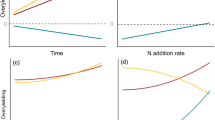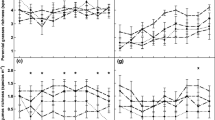Abstract
Nitrogen (N)-induced declines in species richness can be offset by grazing via the suppression of dominant species to increase ground-level light. However, it is not known whether grazing-mediated locally colonized species correspond to N-induced locally extinct species with regard to taxonomy or traits. Data from 11 years of N addition and winter grazing experiments were analyzed to assess species richness dynamics at community and functional group levels. Regarding N treatments, enclosure and N addition were performed during the first 7 years and were then followed by winter grazing with continuous N addition during the next 4 years. Additionally, all treatments were used to compare N-induced local species extinction and grazing-mediated local species colonization. Then, traits of N-induced locally extinct species and grazing-mediated locally colonized species were further correlated with plant traits. We found that N addition induced a decline in plant species richness as a result of both random and non-random species losses. The lost species were closely associated with traits, including low height, non-clonality, low special leaf area (SLA), and low leaf N concentrations, which are relevant to light capture capacity. In contrast, grazing promoted the random colonization of local rare species, thus offsetting the N-induced decline of species richness. However, non-randomly lost species were not rescued by grazing. Grazing-mediated locally colonized species were generally characterized by high leaf carbon (C) concentrations, SLA, and seed mass. Our study provides experimental evidence indicating although grazing offsets N-induced species reduction, shifts in species composition and traits could cause a divergence in ecosystem function facing anthropogenic alterations to nutrient cycles and grazing.






Similar content being viewed by others
References
Anderson TM, Ritchie ME, Mcnaughton SJ. 2007. Rainfall and soils modify plant community response to grazing in Serengeti National Park. Ecology 88:1191–201.
Bakker ES, Ritchie ME, Olff H, Milchunas DG, Knops JMH. 2010. Herbivore impact on grassland plant diversity depends on habitat productivity and herbivore size. Ecology Letters 9(7):780–8.
Berendse F. 1999. Implications of increased litter production for plant biodiversity. Trends in Ecology Evolution 14(1):4–5.
Bobbink R, Hicks K, Galloway J, Spranger T, Alkemade R, Ashmore M. 2010. Global assessment of nitrogen deposition effects on terrestrial plant diversity: a synthesis. Ecological Applications 20(1):30–59.
Borer ET, Seabloom EW, Gruner DS, Harpole WS, Hillebrand H, Lind EM, Adler PB et al. 2014. Herbivores and nutrients control grassland plant diversity via light limitation. Nature 508:517–20.
Bremner JM. 1996. Nitrogen total. In: Sparks DL, Ed. Methods of soil analysis. Part 3: Chemical methods. SSSA Book Series 5. Madison, WI: Soil Science Society of America. p 1085–122.
Chinese Soil Taxonomy Research Group. 1995. Chinese Soil Taxonomy. Beijing, China: China Agriculture Scientech Press.
Clark CM, Cleland EE, Collins SL, Fargione JE, Gough L, Gross KL. 2007. Environmental and plant community determinants of species loss following nitrogen enrichment. Ecology Letters 10:596–607.
Clark CM, Tilman D. 2010. Recovery of plant diversity following N cessation: effects of recruitment, litter, and elevated N cycling. Ecology 91(12):3620–30.
Collins SL, Knapp AK, Jmb R, Blair JM, Steinauer EM. 1998. Modulation of diversity by grazing and mowing in native tallgrass prairie. Science 280:745.
de Graaf MCC, Bobbink R, Roelofs JGM, Verbeek PJM. 1998. Differential effects of ammonium and nitrate on three heathland species. Plant Ecology 135(2):185–96.
De Schrijver An DS, Frenne PD, Ampoorter E, Nevel LV, Demey A, Wuyts K. 2011. Cumulative nitrogen input drives species loss in terrestrial ecosystems. Global Ecology Biogeography 20:803–16.
Dickson TL, Mittelbach GG, Reynolds HL, Gross KL. 2014. Height and clonality traits determine plant community responses to fertilization. Ecology 95:2443–52.
Duprè C, Stevens CJ, Ranke T, Bleeker A, Pepplerlisbach C, Gowing DJG. 2010. Changes in species richness and composition in European acidic grasslands over the past 70 years: the contribution of cumulative atmospheric nitrogen deposition. Global Change Biology 16:344–57.
Foster BL, Gross KL. 1998. Species richness in a successional grassland: effects of nitrogen enrichment and plant litter. Ecology 79(8):2593–602.
Gilliam FS. 2006. Response of the herbaceous layer of forest ecosystems to excess nitrogen deposition. Journal of Ecology 94(6):1176–91.
Gough L, Suding KN. 2012. Incorporating clonal growth form clarifies the role of plant height in response to nitrogen addition. Oecologia 169:1053–62.
Hautier Y, Niklaus PA, Hector A. 2009. Competition for light causes plant biodiversity loss after eutrophication. Science 324:636–8.
Hillebrand H, Gruner DS, Borer ET, Bracken MES, Cleland EE, Elser JJ. 2007. Consumer versus resource control of producer diversity depends on ecosystem type and producer community structure. Proc Natl Acad Sci USA 104:10904–9.
Hurteau M, North M. 2008. Mixed conifer understory response to climate change, nitrogen, and fire. Global Change Biology 14:1543–52.
Isbell F, Reich PB, Tilman D, Hobbie SE, Polasky S, Binder S. 2013. Nutrient enrichment, biodiversity loss, and consequent declines in ecosystem productivity. Proc Natl Acad Sci USA 110:11911–16.
Lamb EG. 2008. Direct and indirect control of grassland community structure by litter, resources, and biomass. Ecology 89:216–25.
Lau JA, Bowling EJ, Gentry LE, Glasser PA, Monarch EA, Olesen WM, Waxmonsky J, Young RT. 2012. Direct and interactive effects of light and nutrients on the legume-rhizobia mutualism. Acta Oecologica 39:80–6.
Lebauer DS, Treseder KK. 2008. Nitrogen limitation of net primary productivity in terrestrial ecosystems is globally distributed. Ecology 89(2):371–9.
Luo Y, Qin G, Du G. 2006. Importance of assemblage-level thinning: a field experiment in an alpine meadow on the Tibetan Plateau. Journal of Vegetation Science 17:417–24.
MacArthur RH, Wilson EO. 1967. The Theory of Island Biogeography. Princeton University Press.
Mikola J, Setälä H, Virkajärvi P, Saarijärvi K, Ilmarinen K, Voigt W, Vestberg M. 2009. Defoliation and patchy nutrient return drive grazing effects on plant and soil properties in a dairy cow pasture. Ecological Monographs 79(2):221–44.
Murphy J, Riley JP. 1962. A modified single solution method for the determination of phosphate in natural waters. Analytica Chimica Acta 27:31–6.
Nihlgård B. 1985. The ammonium hypothesis: an additional explanation to the forest dieback in Europe. Ambio 14(1):2–8.
Oksanen J. 1996. Is the humped relationship between species richness and biomass an artefact due to plot size? Journal of Ecology 84:293–5.
Phoenix GK, Emmett BA, Britton AJ, Caporn SJM, Dise NB, Helliwell R. 2012. Impacts of atmospheric nitrogen deposition: responses of multiple plant and soil parameters across contrasting ecosystems in long-term field experiments. Global Change Biology 18:1197–215.
R Core Team. 2012. R: a language and environment for statistical computing. R foundation for statistical computing, Vienna, Austria. ISBN 3-900051-07-0, URL http://www.R-project.org/.
Song MH, Yu FH, Ouyang H, Cao GM, Xu XL, Cornelissen JHC. 2012. Different inter-annual responses to availability and form of nitrogen explain species coexistence in an alpine meadow community after release from grazing. Global Change Biology 18:3100–11.
Song MH, Guo Y, Yu FH, Zhang XZ, Cao GM, Cornelissen JHC. 2018. Shifts in priming partly explain impacts of long-term nitrogen input in different chemical forms on soil organic carbon storage. Global Change Biology 24(9):4160–72.
Southon GE, Field C, Caporn SJM, Britton AJ, Power SA. 2013. Nitrogen deposition reduces plant diversity and alters ecosystem functioning: field-scale evidence from a nationwide survey of UK heathlands. Plos One 8:e59031.
Stevens MHH, Carson WP. 1999. Plant density determines species richness along an experimental fertility gradient. Ecology 80:455–65.
Stevens CJ, Dise NB, Mountford JO, Gowing DJ. 2004. Impact of nitrogen deposition on the species richness of grasslands. Science 303:1876–9.
Suding KN, Collins SL, Gough L, Clark C, Cleland EE, Gross KL. 2005. Functional- and abundance-based mechanisms explain diversity loss due to N fertilization. Proceedings of the National Academy of Sciences of the United States of America 102:4387.
Tian Q, Liu N, Bai W, Li L, Chen J, Reich PB. 2016. A novel soil manganese mechanism drives plant species loss with increased nitrogen deposition in a temperate steppe. Ecology 97(1):65–74.
Tilman D. 1993. Species richness of experimental productivity gradients: how important is colonization limitation? Ecology 74(8):2179–91.
Tonkin JD, Bogan MT, Bonada N, Rios-Touma B, Lytle DA. 2017. Seasonality and predictability shape temporal species diversity. Ecology 98:1201.
Wolkovich EM, Cook BI, Davies TJ. 2014. Progress towards an interdisciplinary science of plant phenology: building predictions across space, time and species diversity. New Phytologist 201:1156–62.
Worm B, Lotze HK, Hillebrand H, Sommer U. 2002. Consumer versus resource control of species diversity and ecosystem functioning. Nature 417:848–51.
Xia J, Wan S. 2008. Global response patterns of terrestrial plant species to nitrogen addition. New Phytologist 179(2):428–39.
Yang HJ, Li Y, Wu MY, Zhang Z, Li LH, Wan SQ. 2011. Plant community responses to nitrogen addition and increased precipitation: the importance of water availability and species traits. Global Change Biology 17:2936–44.
Yang HJ, Jiang L, Li LH, Li A, Wu MY, Wan SQ. 2012. Diversity-dependent stability under mowing and nutrient addition: evidence from a 7-year grassland experiment. Ecology Letters 15:619–26.
Yang ZL, Hautier Y, Borer ET, Zhang CH, Du GZ. 2015. Abundance- and functional-based mechanisms of plant diversity loss with fertilization in the presence and absence of herbivores. Oecologia 179:261–70.
Zhang Y, Lü X, Isbell F, Stevens C, Han X, He N. 2014. Rapid plant species loss at high rates and at low frequency of n addition in temperate steppe. Global Change Biology 20(11):3520–9.
Zhou XM. 2001. Alpine Kobresia meadows in China. Beijing, China: Science Press. pp 51–62.
Acknowledgements
The study was supported by the Strategic Priority Research Program of Chinese Academy of Sciences (XDA2005010401), and the National key research and development program (2016YFC0502001, 2016YFC0501803), and the National Natural Science Foundation of China (41671263), and the Qinghai Innovation Platform Construction Project (2017-ZJ-Y20). We declare no conflict of interest.
Author information
Authors and Affiliations
Corresponding authors
Additional information
Author's Contribution
M.-H.S. and X.-L. X. conceived of the idea and designed the experiment; M.-H.S., J. C., Y.-K. L., and J.-Q. G. carried out the experiment and provided the data of livestock quantity and grassland area; M.-H. S. analyzed the data and wrote the first draft; M.-H. S., X.-L. X., and H. OY. discussed the ideas and gave insightful suggestion for the improvement in the manuscript; and all the authors contributed to edit of the manuscript.
Electronic supplementary material
Below is the link to the electronic supplementary material.
Rights and permissions
About this article
Cite this article
Song, MH., Chen, J., Xu, XL. et al. Grazing Offsets Nitrogen Enrichment Effects on Species Richness by Promoting the Random Colonization of Local Species in an Alpine Grassland. Ecosystems 23, 278–291 (2020). https://doi.org/10.1007/s10021-019-00403-8
Received:
Accepted:
Published:
Issue Date:
DOI: https://doi.org/10.1007/s10021-019-00403-8




